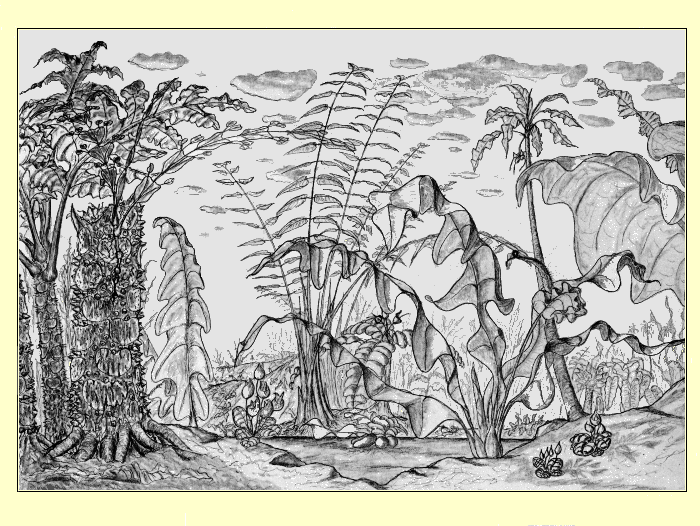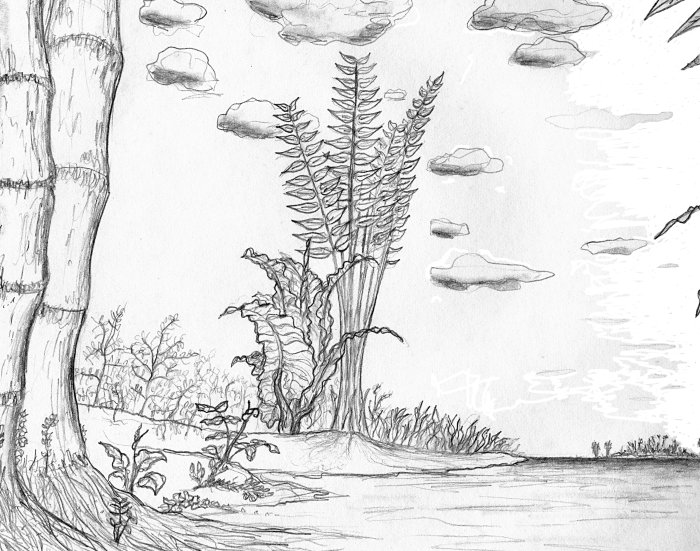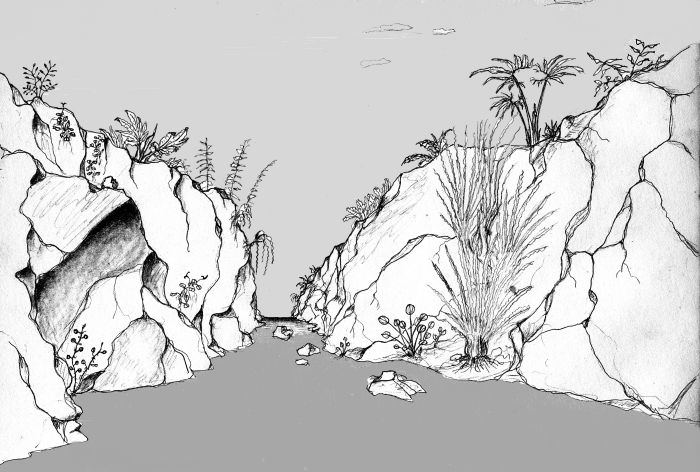Landscapes on Aroidia

You have arrived on Aroidia, an intensely tropical planet orbiting a binary star system. All life here represents variations on the aroid theme. Animal life, as we know it on Earth, is absent on Aroidia; however, to the untrained observer, the place is teeming with moving entities. Every living thing here is symbiotic and some life has as many as five sexes. Aroidia is one huge ocean, with very little "dry land" as we on Earth understand the term.
Therefore, what you see in the picture is not a geologic land mass, but is one of the oldest and largest of the biological archipelagos, one of many floating on the vast ocean of Aroidia. These floating islands are formed by the aggregation of root systems from the plants which grow on them, plus the floating debris that has been captured by these roots. The primary contributor to the root mass is Pinnatidendron altissimum; this gigantic plant is ubiquitous on every biological archipelago. Also note the large plant near the Pinnatidendron; this is Macroalocasia triangularis. The large trunks at the left edge of the picture are Dendroaglaonema undulata.

Many different Aroidian habitats exist, ranging from aquatic to xerophytic. Some habitats are formed by the growth and development of various Aroidian genera; the genus Musarum grows specifically in habitats that form as a result of the maturation of colonies of the genus Cryptophyllum. Another genus, Spirophyllum, consists of plants living as hemiepiphytes on other treelike species, and that grow leaves in a single spiral pattern.

Above is an example of one of the rare geological islands on Aroidia. These relatively inhospitable habitats are much drier than the biological archipelagos and thus have plant life that is more xerophytic in nature.
Some Aroidian genera have very complex life cycles, such as the anthropomorphic Aroidians that undergo a process called phytometamorphosis in order to reach sexual maturity, the genus Trispadia, which reproduces sexually only after a successful fusion of three different plants, and the most complex of all, Aroidendron, requiring five sexes for successful reproduction. One of the five gametophytes that each contributes a gamete to the reproduction of Aroidendron is Pinnatidendron; another is Lanceolum bicorrugatum.
Mapping Aroidia is nearly impossible, as each archipelago is moved around daily by winds and ocean currents.
The collective of all life on Aroidia is not merely symbiotic, but functions as a global organism in spite of the apparent existence of many distinct and separate life forms. The nature of the global organism becomes quite apparent during the Aroidian storm season. At that time, due to Aroidia's eccentric orbit and peculiar atmospheric dynamics, two gigantic storm systems form, one with an "eye" at the north pole and the other with an "eye" at the south pole. The regions of greatest wind force are the subpolar areas, near the eye rims, much as in Terran cyclones. However, intense shear forces are experienced in the equatorial regions, as tremendous turbulence and smaller cyclonic storms are generated by the conflicting wind zones of the two systems.
In preparation for the storm season, many life forms on the planet undergo a fascinating "disintegration" in which the cell plasma emerges from every cell and moves, amoeba-like, to the protection of the depths of the ocean. Each of these cells "de-differentiates" so that, genetically, all of them are identical. This means that what appear to be different species and genera of organisms are actually the differentiated components of the planetary organism. In this context, then, the genera can be thought of as analogous to organs, and the species analogous to organ functions.
On Aroidia are found two sentient, intelligent races of beings. One of them is aquatic and considered "native" and the other is terrestrial and considered "non-native". The non-native or alien, intelligent race existing on Aroidia has cells of a genetic constitution that is almost indistinguishable from the rest of the Aroidian life forms. This apparent anomaly is explained by another characteristic of the Aroidian organism, and that is an ability to perform genetic information assimilation. At some point in Aroidian history, an alien bipedal humanoid visited Aroidia and came into direct, intimate contact with Aroidian cellular tissue, either intentionally or unintentionally. The global intelligence, via this cellular material, analyzed DNA from the alien humanoid, and through replicative transcription within the Aroidian organism, the bipedal body morphotype was formed. However, actual alien genetic material was not spliced into the Aroidian genome. Consequently, the term "alien" refers not to the origin of the life form itself, but to the origin of the coded genetic information or template used to produce that life form.
Be sure to read my Aroidia articles on the Dave's Garden website. The first of twelve debuted December 20, 2007. Links to each Aroidia article I've published are below:
- Aroids of the imagination I
- Aroids of the imagination II
- Aroids of the imagination III
- Aroids of the imagination IV
- Aroids of the imagination V
- Aroids of the imagination VI
- Aroids of the imagination VII
- Aroids of the imagination VIII
- Aroids of the imagination IX
- Aroids of the imagination X
- Aroids of the imagination XI
- Aroids of the imagination XII
| In the Lab | In the Field | The Species | Fruiting | The Hybrids |